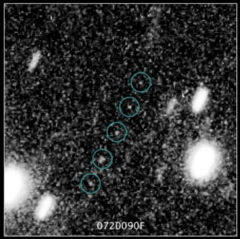2014 MT69
 Discovery image sequence | |
| Discovery[1] | |
|---|---|
| Discovered by | Hubble Space Telescope |
| Discovery date | June 24, 2014 |
| Designations | |
| MPC designation | 2014 MT69 |
| MPO 335305,[1] 0720090F,[2] 7[3][4] | |
| Trans-Neptunian object (TNO) | |
| Orbital characteristics[5] | |
| Epoch 21 July 2014 (JD 2456859.5) | |
| Uncertainty parameter 9 | |
| Observation arc | 40 days |
| Aphelion | 49.242 ± 1,133.6 AU (7.3665 ± 169.5841 Tm) |
| Perihelion | 40.719 ± 2,125.7 AU (6.0915 ± 318.0002 Tm) |
| 44.980 ± 1,035.5 AU (6.7289 ± 154.9086 Tm) | |
| Eccentricity | 0.094737±68.05 |
| 301.68±10420 yr | |
Average orbital speed | 4.5? km/s |
| 301.50±1613° | |
| 0° 0m 11.762s ± 0° 6m 46.152s / day | |
| Inclination | 3.1589°±12.912° |
| 141.98°±207.67° | |
| 206.66°±8735.5° | |
| Earth MOID | 39.7121 AU (5.94085 Tm) |
| Jupiter MOID | 35.7377 AU (5.34628 Tm) |
| TJupiter | 5.961 |
| Physical characteristics | |
| Dimensions | 27–92 km (17–57 mi)[6] |
| 0.04–0.15[4] | |
| 27.4[4] | |
| 11.483±0.63034[5] | |
|
| |
2014 MT69 (internally designated 0720090F in the context of the Hubble Space Telescope, and 7 in the context of the New Horizons mission) is a Kuiper belt object (KBO) and was formerly a potential flyby target for the New Horizons probe.[3]
Discovery and naming
2014 MT69 was discovered with the help of the Hubble Space Telescope (HST)[7] because the object has a magnitude of 27.3, which is too faint to be observed by ground-based telescopes. Preliminary observations by the HST searching for KBO flyby targets for the New Horizons probe started in June 2014, and more intensive observations continued in July and August.[8][9] 2014 MT69 was first discovered in observations on June 24, 2014 during the preliminary observations, but it was designated 0720090F at the time,[2] nicknamed "7" for short.[3][4] Its existence as a potential target of the New Horizons probe was revealed by NASA in October 2014,[4] but the official name 2014 MT69 was not assigned by the Minor Planet Center (MPC) until March 2015 after better orbit information was available.[3] The parameters of the orbit have the extremely large uncertainty of 9 because follow-up observations after discovery eliminated 2014 MT69 as a potential target of the New Horizons probe, and no further follow-up observations were made.[4]
Potential targets of the New Horizons mission
Having completed its flyby of Pluto, the New Horizons space probe will be maneuvered for a flyby of at least one Kuiper belt object (KBO). There were several potential targets considered for the first such flyby. Potential target 2014 MT69 has a diameter between 27–92 km (17–57 mi), which is smaller than the other potential targets of the New Horizons probe. A potential encounter with the probe initially looked more feasible for 2014 MT69 than for 2014 MU69, but follow-up observations eventually ruled out 2014 MT69 as a potential target.[3][4] The potential targets for the New Horizons probe were PT1 and PT3, the KBOs 2014 MU69 and 2014 PN70, and the probe has sufficient fuel to maneuver to either PT1 or PT3. Potential target PT2, the KBO 2014 OS393, is no longer under consideration as a potential target.[10]
On 28 August 2015, the New Horizons team announced the selection of 2014 MU69 as the next flyby target.[11]
See also
References
- 1 2 "2014 MT69". Minor Planet Center. 2014-08-03.
- 1 2 "Hubble Survey Finds Two Kuiper Belt Objects to Support New Horizons Mission". HubbleSite news release. Space Telescope Science Institute. July 1, 2014.
- 1 2 3 4 5 Zangari, Amanda (March 28, 2015). "Postcards from Pluto". Tumblr.
- 1 2 3 4 5 6 7 Buie, Marc (October 15, 2014). "New Horizons HST KBO Search Results: Status Report" (PDF). Space Telescope Science Institute. p. 23.
- 1 2 "JPL Small-Body Database Browser: (2014 MT69)" (2014-08-03 last obs; arc: 40 days). Retrieved 6 May 2016.
- ↑ "ABSOLUTE MAGNITUDE (H)". Archived from the original on 2011-07-23.
- ↑ J. R. Spencer; M. W. Buie; et al. (2015). "The Successful Search for a Post-Pluto KBO Flyby Target for New Horizons Using the Hubble Space Telescope" (PDF). European Planetary Science Congress (EPSC) Abstract. Copernicus Office.
- ↑ "Hubble to Proceed with Full Search for New Horizons Targets". HubbleSite news release. Space Telescope Science Institute. July 1, 2014.
- ↑ Schmidt, Klaus (2 July 2014). "Hubble to Proceed with Full Search for New Horizons Targets". International Space Fellowship.
- ↑ Powell, Corey S. (March 29, 2015). "Alan Stern on Pluto's Wonders, New Horizons' Lost Twin, and That Whole "Dwarf Planet" Thing". Discover.
- ↑ Cofield, Calla (28 August 2015). "Beyond Pluto: 2nd Target Chosen for New Horizons Probe". Space.com.